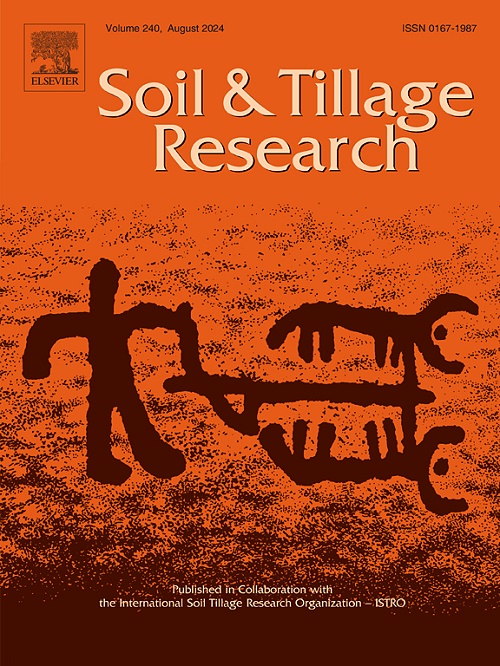N2O emissions from controlled-release and conventional N-fertilizers applied to red-yellow soil in Okinawa, Japan
IF 6.8
1区 农林科学
Q1 SOIL SCIENCE
引用次数: 0
Abstract
In Okinawa, Japan, controlled-release N fertilizers (CRFs) are promoted to reduce labor and to increase fertilizer use efficiency. However, N2O emissions from N fertilizer applied to the widely prevalent Kunigami mahji (red-yellow soil), a local soil in the region, have not been examined so far. We conducted two laboratory experiments during winter and spring to compare N2O emissions between CRF and standard fertilizer (ammonium sulfate: AS) in kunigami mahji. Two seasons were selected to explore the effects of moisture and temperature on N2O emissions in relation to N fertilization. For each experiment, three soil chambers were used, each containing 1.4 kg of soil: one served as a control, and the other two received 1 g of nitrogen from either a linear-release-type CRF with 42 % N or AS with 21 % N. Over 9 weeks, N₂O emissions from the headspace of each chamber were measured every minute for 20 min, followed by 70 min of ventilation, in a continuous 90-minute cycle repeated throughout the study. Soil moisture, soil temperature, NO, and NO3-N and NH4-N in leachate were also analyzed. In Exp A (winter), nitrification was dominant, and N2O emission from CRF (emission factor, EF, 0.4 %) was 88 % lower than that from AS (EF 3.9 %). In Exp B (spring), denitrification was dominant, and N2O emission from CRF (EF 1.9 %) was 53 % lower than that from AS (EF 4 %). The frequently lower water-filled pore space (WFPS) in Exp A than in Exp B facilitated higher NO emission from AS than from CRF. Due to the consistently high WFPS in Exp B, most of the NO3− in the soil was reduced to N2O and N2. N is more readily available in AS than in CRF, facilitating higher cumulative leaching of NH4-N from AS. However, in both experiments, AS was denitrified more than CRF, producing more N2O and resulting in lower leaching of NO3-N. Our results highlight that choosing the appropriate form of fertilizer and good management of soil moisture content can reduce N2O emissions and leaching of NO3− and NH4+.
日本冲绳县红黄壤控释氮肥和常规氮肥的N2O排放
在日本冲绳推广控释氮肥(CRFs),以减少劳动力,提高肥料利用率。然而,对该地区普遍存在的红黄土(Kunigami mahji)施用氮肥所产生的N2O排放,迄今尚未进行研究。在冬季和春季进行了两个室内试验,比较了CRF与标准肥料(硫酸铵:AS)对kunigami mahji N2O排放的影响。选取两个季节,探讨水分和温度对氮肥处理下氮氧化物排放的影响。在每个实验中,使用三个土壤室,每个室含有1.4 kg的土壤:一个作为对照,另外两个从含42 % N的线性释放型CRF或含21 % N的as中获得1 g氮。在9周内,每个室顶空的N₂O排放量每分钟测量20 min,然后进行70 min的通风,在整个研究过程中重复连续90分钟的循环。土壤湿度、土壤温度、渗滤液中NO、NO3-N和NH4-N也进行了分析。试验A(冬季)以硝化作用为主,CRF(排放因子EF, 0.4 %)的N2O排放量比AS(排放因子EF, 3.9 %)低88 %。在试验B(春季)中,反硝化作用占主导地位,CRF (EF 1.9 %)的N2O排放量比AS (EF 4 %)低53 %。实验A的充水孔隙空间(WFPS)往往低于实验B,这促使AS比CRF释放更多的NO。由于实验区B的WFPS一直很高,土壤中大部分NO3−被还原为N2O和N2。氮在AS中比在CRF中更容易获得,促进了AS中NH4-N的累积淋失。然而,在两个实验中,AS的反硝化作用都大于CRF,产生更多的N2O,导致NO3-N的浸出更低。研究结果表明,选择合适的肥料形式和良好的土壤水分管理可以减少N2O的排放和NO3−和NH4+的淋溶。
本文章由计算机程序翻译,如有差异,请以英文原文为准。
求助全文
约1分钟内获得全文
求助全文
来源期刊

Soil & Tillage Research
农林科学-土壤科学
CiteScore
13.00
自引率
6.20%
发文量
266
审稿时长
5 months
期刊介绍:
Soil & Tillage Research examines the physical, chemical and biological changes in the soil caused by tillage and field traffic. Manuscripts will be considered on aspects of soil science, physics, technology, mechanization and applied engineering for a sustainable balance among productivity, environmental quality and profitability. The following are examples of suitable topics within the scope of the journal of Soil and Tillage Research:
The agricultural and biosystems engineering associated with tillage (including no-tillage, reduced-tillage and direct drilling), irrigation and drainage, crops and crop rotations, fertilization, rehabilitation of mine spoils and processes used to modify soils. Soil change effects on establishment and yield of crops, growth of plants and roots, structure and erosion of soil, cycling of carbon and nutrients, greenhouse gas emissions, leaching, runoff and other processes that affect environmental quality. Characterization or modeling of tillage and field traffic responses, soil, climate, or topographic effects, soil deformation processes, tillage tools, traction devices, energy requirements, economics, surface and subsurface water quality effects, tillage effects on weed, pest and disease control, and their interactions.
 求助内容:
求助内容: 应助结果提醒方式:
应助结果提醒方式:


